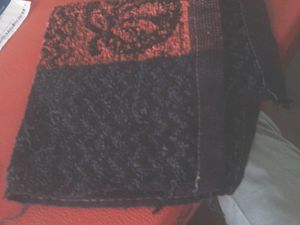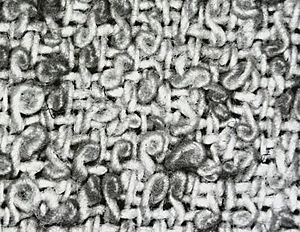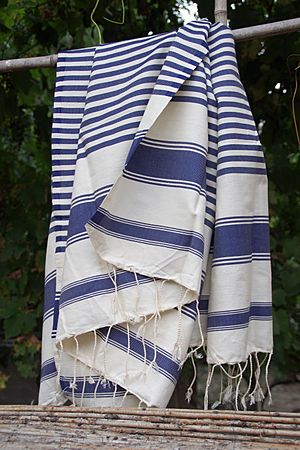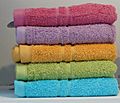Towel facts for kids
A towel is a piece of cloth or paper that helps you dry things. You can use towels to dry yourself after a shower, or to wipe a table clean. There are many kinds of towels, like a beach towel or a small washcloth for cleaning.
Contents
The History of Towels
Towels have been around for a long time! Some old studies from the Middle Ages show that people often carried a knife and a towel with them. However, many people believe the modern towel was invented in the city of Bursa, Turkey, during the 1600s.
How Turkish Towels Started
These first Turkish towels were flat pieces of cotton or linen. They were called peshtamal. People often embroidered them by hand. These towels were long enough to wrap around your body. They were first quite narrow, but today they are wider. They are often about 90 by 170 centimeters (35 by 67 inches). Peshtamal towels were popular in Turkish baths because they stayed light when wet and could soak up a lot of water.
Towels Grow and Change
As the Ottoman Empire grew, so did the use of towels. Weavers, who were good at making carpets, started adding more fancy designs to towels. By the 1700s, towels began to have small loops sticking out from the fabric. These looped towels were called havly. Over time, this word changed to havlu, which is the Turkish word for towel today. It means 'with loops'.
Towels became much more affordable in the 1800s. This happened because of the cotton trade and new machines. Factories could make cotton terry-toweling fabric by the yard. Shops also started selling ready-made towels. Today, you can find towels in many sizes, materials, and designs.
Different Types of Towels
There are many different kinds of towels, each with its own special use!
- A bath towel is used to dry your body after a bath or shower. It is usually a rectangle, often about 30 by 60 inches (76 by 152 cm). Most bath towels are made of a fabric called terrycloth.
- A cooling towel is a special fabric. When you make it wet and put it on your body, it helps cool you down. This is great for hot weather or after exercise.
- A beach towel is usually bigger than a bath towel. It often has bright, colorful patterns. People use them to dry off after swimming. But their main job is to give you a comfy surface to lie on at the beach. They can also offer privacy when changing clothes.
- A bath sheet is even larger than a regular bath towel. It can wrap around your whole body. People use them after bathing, in saunas, at the beach, or for massage.
- A foot towel is a small, rectangular towel. You place it on the bathroom floor to stand on after a shower or bath.
- A hand towel is much smaller than a bath towel. It is used for drying your hands after washing them.
- An oven towel is a useful towel for the kitchen. You can use it for many tasks, like handling hot dishes.
- A paper towel is a piece of paper you use once and then throw away. They often come on a roll with tear-off sheets.
- A disposable towel is meant for one person to use, but not always just once. You can reuse it, but you don't wash it. Hospitals and hotels often use them for hygiene.
- A show towel is a decorative towel. It might have fancy trim or embroidery. People use them to make a bathroom look nice, especially in the United States. They are usually not for drying, as washing can damage the decorations.
- A sports towel is made from special synthetic materials. Swimmers and divers first used them because they soak up a lot of water. You can wring them out when they are wet, and they will still absorb more water. They are also small and easy to carry.
- A sweat towel or gym towel is often the size of a hand towel. You use it during a workout to wipe away sweat. Many gyms also require you to use them to wipe down machines after you're done.
- A kitchen towel can mean different things. In America, it's a dish towel. In the UK and Canada, it's a tea towel. In the UK, it can also mean a paper towel.
- A tea towel or tea cloth (UK and Canada) is called a dishtowel in America. These absorbent towels are used in the kitchen to dry dishes and cutlery. They can also be wrapped around a teapot to keep the tea warm. They are often made of cotton.
- Microfiber towels are very popular because they soak up a lot of water and dry quickly. They are made of tiny synthetic fibers. These towels are great for travel, the gym, or outdoor activities. They are light and take up little space. Their quick-drying nature also helps stop bad smells and germs.
- A tenugui is a type of hand towel from Japan. It's used like a tea towel or washcloth. But it can also be used for decoration, as a headband, or to wrap gifts.
- A cloth towel dispenser is a system with a long cloth towel on rollers. It's an alternative to paper towels in public washrooms.
- A bar towel is a small, absorbent towel used in bars. They are sometimes given away as free gifts.
- A fingertip towel is a small towel placed next to the sink or in a guest bedroom. Hosts might put a note on them for guests to use.
- A golf towel is a small towel with a loop or clip. You attach it to a golf bag to dry hands, golf balls, and clubs.
- A baby towel is a smaller towel with a hood sewn into one corner. The hood helps cover a baby's head after a bath.
- A peshtemal is a special multipurpose towel from Anatolia (part of Turkey).
- A poncho towel is a towel you can wear. It's made for drying off and changing clothes, often used at the pool or beach.
- A fouta towel is a Tunisian towel used in hammams (bathhouses) and at the beach. It can also be worn as a pareo.
Images for kids
See also
 In Spanish: Toalla para niños
In Spanish: Toalla para niños







